Fieldwork campaign
Butrint
The coastal site of Butrint is situated on a peninsula in south-western Albania, opposite the island of Corfu and Apulia in southern Italy (across the Adriatic Sea). In Medieval times, Butrint served as a connecting bridge between East and West – between Byzantium and the Latin world.
- Duration
- 2010 - 2015
- Contact
- Joanita Vroom
- Funding
-
 Innovational Research Incentives Scheme VIDI - Nederlandse Organisatie voor Wetenschappelijk Onderzoek (NWO)
Innovational Research Incentives Scheme VIDI - Nederlandse Organisatie voor Wetenschappelijk Onderzoek (NWO)
- Partners
Large-scale excavations have taken place in Butrint for the last 30 years under the direction of the Albanian Institute of Archaeology in Tirana and of Professor Richard Hodges with the collaboration of the Universities of Eastern Anglia and Sheffield (UK).
The excavations have established that Butrint is a multi-period site, occupied from Archaic until Post-Medieval times. Some of its most fascinating monuments have survived, and can still be visited today (among these are the Acropolis, the Forum with its theatre, the Baptistery, the Triconch Palace, and the Venetian Tower).
On the other side of the Vivari Channel, south of the peninsula of Butrint, additional excavations and surveys were carried out by the British-Albanian team. These took place in the Triangular Fortress, at Ali Pasha’s fortress and in the Roman and Byzantine suburb on the Vrina Plain, and brought to light important architectural remains and fascinating finds.

Research aims
One of the main objectives of the VIDI research project is to trace patterns of production, exchange and consumption between Butrint and the other three urban sites. Our analysis so far suggests that Butrint’ s contacts reached much further than to its neighbouring regions, such as southern Italy.
In addition, the team explores the spatial distribution of different wares and forms on the site, based on the quantities found, in order to understand ceramic production, distribution and consumption within a settlement and between periods. Finally, the use of space in Butrint after Late Antiquity is explored as well as changes in socio-economic and political circumstances. These last ones led to the transformation of private villas into burial grounds and industrial areas of mussel processing, as well as the transformation of Roman baths into churches.

Results & publications
Gwynne, P., Hodges, R. and Vroom, J., 2014, ‘Archaeology and epic: Butrint and Ugolino Verino’s Carlias’, Papers of the British School at Rome 82: 199-235
Vroom, J. 2013a, ‘Digging for the ‘Byz’. Adventures into Byzantine and Ottoman archaeology in the eastern Mediterranean’, Pharos 19.2: 79-110.
Vroom, J. 2013b, ‘The Medieval and Post-Medieval pottery finds’, in A. Sebastiani et al. ‘The Medieval church and cemetery at the Well of Junia Rufina’, in: I.L. Hansen, R. Hodges and S. Leppard (eds.), Butrint 4: The Archaeology and Histories of an Ionian Town, Oxford, Oxbow Books: 234-240.
Vroom, J. 2012a, ‘From one coast to another: Early Medieval ceramics in the southern Adriatic region’, in: S. Gelichi and R. Hodges (eds.), From One Sea to Another. Trading Places in the European and Mediterranean Early Middle Ages, Proceedings of the International Conference Comacchio, 27th-29th March 2009, Turnhout, Brepols: 337-352.
Vroom, J. 2012b, ‘Early Medieval pottery finds from recent excavations at Butrint, Albania’, in: S. Gelichi (ed.), Atti del IX congresso internazionale sulla ceramica medievale nel Mediterraneo, Venezia, Scuola Grande dei Carmini, Auditorium Santa Margherita, 23-27 novembre 2009, Florence, All’ Insegno del Giglio: 289-296.
Vroom J. 2008, ‘Dishing up history: Early Medieval ceramic finds from the Triconch Palace in Butrint’, Mélanges de l’Ecole française de Rome – Moyen Âge 120-2: 291-305.
Hodges R. and Vroom J. 2007, ‘Late Antique and Early Medieval ceramics from Butrint, Albania’, in: S. Gelichi and C. Negrelli (eds.), La circolazione delle ceramiche nell’adriatico tra tarda antichità ed altomedieovo. III Incontro di studio CER.AM.IS ( Documenti di archeologia 43), Mantova, SAP Società Archeologica: 375-388
Vroom J. 2006, ‘Corfu’s right eye: Venetian pottery in Butrint (Albania)’, in M. Guštin, S. Gelichi and K. Spindler (eds .), The Heritage of the Serenissima. The Presentation of the Architectural and Archaeological Remains of the Venetian Republic. Proceedings of the International Conference Izola - Venezia 4 - 9.11.2005, Koper, Založba Annales: 229-236.
Vroom J. 2004, ‘The Medieval and Post-Medieval fine wares and cooking wares from the triconch palace and the baptistery’, in: R. Hodges, W. Bowden and K. Lako (eds.), Byzantine Butrint: Excavations and Survey 1994-99, Oxford, Oxbow Books: 278-292.
Gilkes O., Crowson A., Hodges R., Lako K. and Vroom J. 2002, ‘Medieval Butrint: Excavations at the Triconch Palace 2000 and 2001’, Archeologia Medievale 29: 343-353
